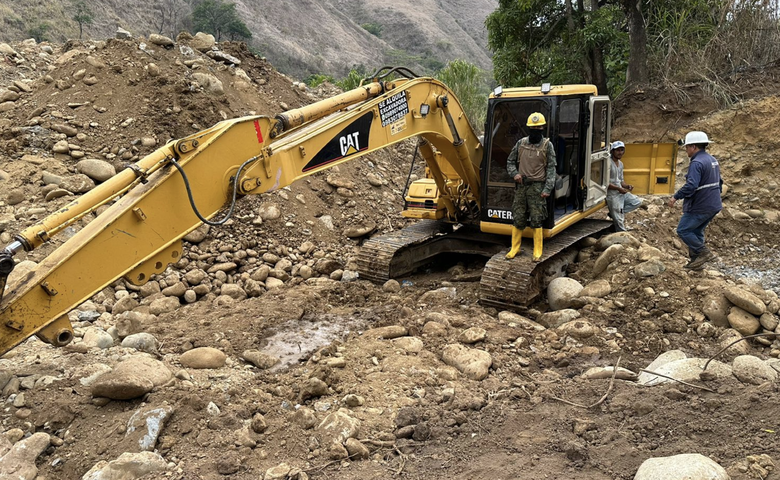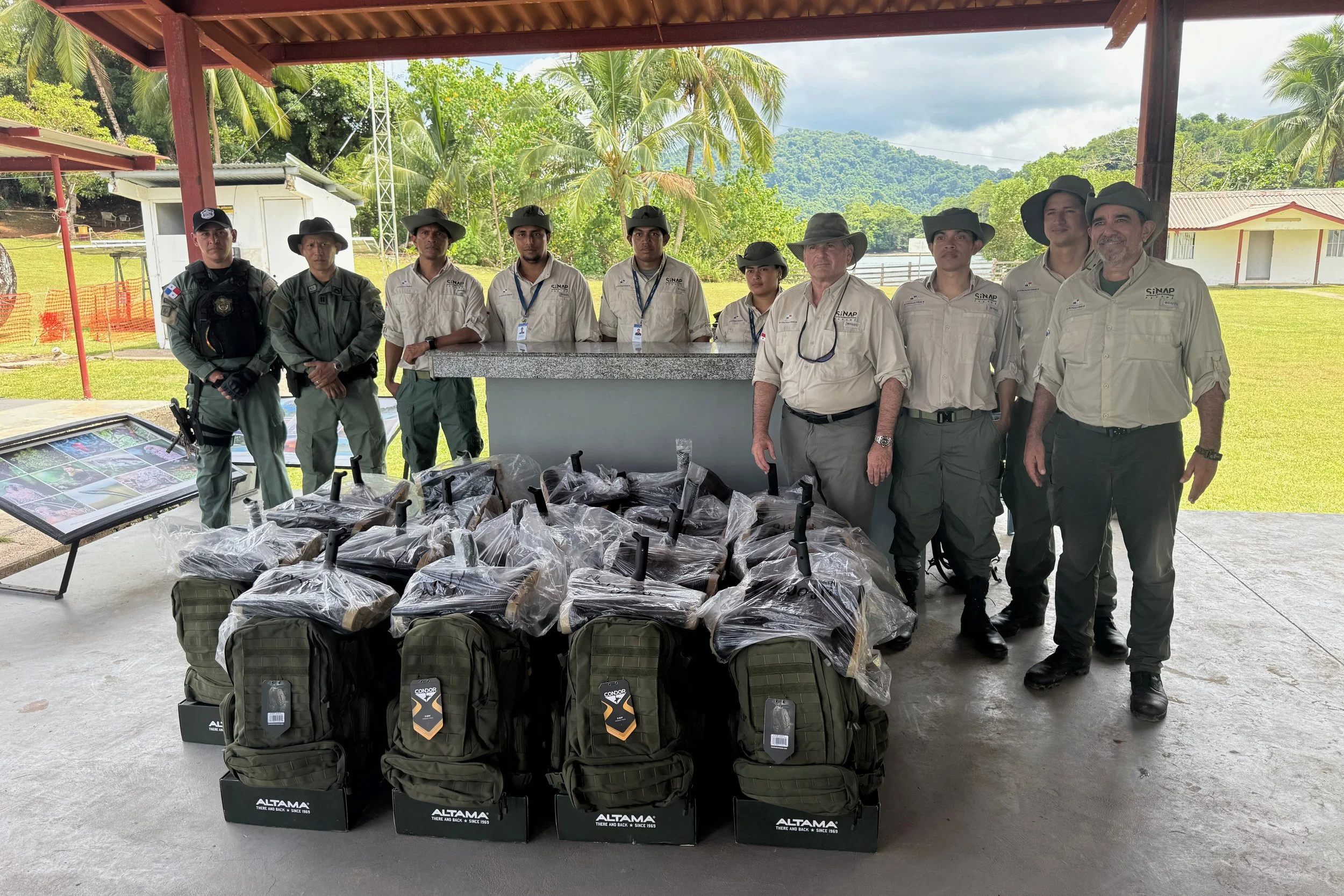GC Mission Against Illegal Mining In Podocarpus National Park, Ecuador
Global Conservation’s Executive Director and Director of South America were on mission this week to assist Podocarpus National Park to remove 1,000+ illegal miners from deep within the protected area.
In the last 3 years, illegal miners bulldozed an 8 kilometers road into the national park using heavy machinery and have large mining operations with over three thousand miners destroying the national park. In August 2023, a violent invasion of the Los Lobos criminal organization took over control of the illegal gold mining operations leading the government to finally send in military troops to clear out the illegal miners.
With only 20 active park rangers, little funding for active patrolling, no weapons and little operational support, no working radio system, or necessary ranger training to deal with violent criminals, the Podocarpus National Park Authority has been severely limited in its ability to respond to the illegal mining crisis which has been destroying the park.
In Podocarpus National Park, there are over 250 illegal mining camps in the provinces of Zamora Chinchipe y Loja and over 3,000 illegal miners operating within the national park.
Gold has long been considered a safe haven for investors and a hedge against inflation. In recent years, its price hit record highs, and the increase has driven a surge in mining.
Since the national parks creation in 1982, only two small entrances and visitor facilities have been built, while 96% of the national park has been left unattended with only 10-12 rangers on duty to protect over 120,000 hectares of rugged terrain from high Andes mountains to the deep tropical forests of the Amazon.
This lack of active patrolling against illegal mining and logging into the national park by mafia-like syndicates employing thousands of miners, has led to today’s destruction of Ecuador’s UNESCO World Heritage, one of Ecuador’s greatest national parks second only to Yasuni Biosphere Reserve.
Global Conservation’s mission to Podocarpus National Park has led to a joint plan for Anti-Mining Operations with the Park Authority, Provincial Government and the Ecuadorian Military to remove illegal miners, restore the damaged ecosystem and develop tourism, guide association and indigenous community protection for one of the last intact tropical forests in Ecuador.
Only by active patrolling, tourism and guides in the national park can the invasion of illegal miners be stopped for good. As well, by proving jobs and business opportunities in the tourism sector, can a long-term solution be found despite rising gold prices driving the national park’s destruction.
Fighting Back Against Illegal Mining in the National Park
After decades of illegal miners destroying one of Ecuador’s most pristine and scenic national parks, the government has requested support of Global Conservation for anti-mining operations to remove over 3,000 miners working deep in the national park.
Funded largely by drug cartels and driven by poverty, tens of thousands of miners have descending into the Amazon and rainforests of Bolivia, Ecuador, Peru and Colombia to find their Eureka – gold in the rivers.
Narcotics trafficking is major source funding of the key drivers of ecosystem destruction – massive amounts of illicit money is being laundered through illegal mining, cattle ranching, illegal logging and land grabbing, too often at the expense of already endangered national parks in developing countries.
Since as early as 2000, as many as 3,000 miners had taken over the core area of Rio San Luis in Podocarpus National Park. The miners opened hundreds of rudimentary mines and set up processing mills. The miners are backed by mafia-like mining financiers who offer start-up capital to be repaid in sacks of ore.
Now, these riches have attracted criminal gangs – Los Lobos entered Podocarpus National Park in August 2023 and forcefully took over mining operations and began extorting money. The next month, the military raided the mining camps and destroyed six large excavators and confiscated many pumps and other equipment.
Organized crime has diversified its illicit activities in Ecuador into illegal mining, with serious environmental consequences in large parts of the country, contributing to violence and human rights abuses and worsening insecurity. According to Fausto Cobo, director of Ecuador’s Strategic Intelligence Center (CIES), the state faces a new “unconventional” threat that converges with other criminal activities such as narcotrafficking.
In 2022, Operation Manatí was carried out against illegal mining, authorities seized 107 excavators, which remain in a fairground. In the early morning of February 13, 2022, more than 1,500 Armed Forces and National Police personnel carried out a mega operation to stop large-scale illegal gold mining in the Yutzupino area of Napo province, in the Ecuadorian Amazon.
The indiscriminate use of large amounts of heavy machinery has caused serious environmental damage in the watersheds of the Yatunyaku and Yutzupino rivers, tributaries of the Napo River.
Ecuadorian Minister of Government Alexandra Vela pointed out that a single one of these machines can cost up to $250,000 and compared those who finance illegal mining activities to narcotraffickers. “The national government is not going to allow illicit activities, such as illegal mining developed on the same level as a narcotrafficking enterprise,” she told the press.
In the September 2023 Anti-Mining Operation, the military seized weapons, ammunition, gas cylinders in Podocarpus National Park. A total of 500 troops, including military personnel, police and other institutions, participated in the operation against illegal mining.
The statement from the Armed Forces indicates massive soil removals, erosion, forest destruction, tree felling, and artificial channeling of natural waters has caused major environmental damage. The National State Public Security Council (COSEPE) declared illegal mining as a threat to security in Ecuador. Within this framework, the Armed Forces work on these activities.
Mercury Poisoning River Communities
Illegal mining in the rivers of Podocarpus National Park has contaminated the drinking water and fish for all the towns and villages of southern Zamora and Loja provinces, affecting over 120,000 people.
In Ecuador, a lot of mercury is used in gold extraction, despite the fact that the Mining Law prohibits it since 2015. Ecuador was, in 2013, the fourth country in Latin America that imported the most mercury. However, there is no valid prohibition. In Zamora Chinchipe you can easily find mercury. After being used to recover gold in its purest state, that mercury is discarded along with the tailings water and goes to rivers and water sources.
Mercury poisoning of local and indigenous communities water sources will lead to major health issues due to continual exposure from drinking poisoned water and eating fish with high mercury concentration.
Miners add liquid mercury to a slurry of gold and sand which is vaporized leaving behind purer gold. Mercury ends up in human bodies through the rivers water and fish eaten by downstream communities who are already reporting pains in their muscles, heads, and stomachs, as well as babies and the elderly experiencing blood in their feces.
Researchers are citing the health impacts on downstream villages of Mercury use in gold mining. Babies are being exposed in the whom to mercury when mothers consume mercury-contaminated fish and drink river waters. Such exposure can have subtle but permanent neurodevelopmental effects. Babies are most vulnerable as their brain is still developing.
Riverside communities are demanding medical specialists to investigate potential links between mercury exposure and their symptoms. They also want more studies performed on fish from their rivers. Indigenous communities rely on fish for their survival.
Global Conservation Program – 2024 Proposed: Global Park Defense for Podocarpus National Park
New Command Center in Loja
Park Entry Security Stations - North - Central - South
Satellite Monitoring
SMART Patrol System Deployment & Training
Global Forest Watch & GLAAD Fire Alerts
Radio Network + Handsets
Satellite Communicators, Smartphones, Drones and Cameras
Indigenous Communal Reserve Protection
Global Park Defense Systems and Training
Tourism Development and Trail Network
The Andes to Amazon Trail
Global Conservation is promoting the development of tourism and guided hiking as a replacement alternative to illegal mining in the park. A new Podocarpus “Andes to Amazon” trail will allow hikers to experience the many distinct ecosystems, diverse flora and fauna, and safely travel and lodge at different locations within the national park led by qualified and certified guides.
Global Conservation is assisting in the planning of a network of ranger stations and visitor lodges, combined with a trained and certified Podocarpus Guide Association involving former miners, poachers, indigenous communities, and naturalist experts, as well promoting the Podocarpus “Andes to Amazon” Trail on a dedicated website with a targeted social media marketing campaign.
About Podocarpus National Park
Declared a UNESCO World Heritage Biosphere in 2013, over 25% of Ecuador’s plant species can be found within 2% of the national territory, including half of Ecuador's bird species (629 species), and the Andean Bear, Mountain Tapir, Puma and Jaguar. Created in 1982, Podocarpus National Park is located in the provinces of Zamora Chinchipe and Loja, in the south-east of Ecuador near the Peruvian border. One of Peru’s most spectacular national parks, on the level of Yasuni or Galapagos, if covers over 146,000 hectares and provides water to hundreds of thousands of people from the Bombuscaro, Nangaritza, Numbala, and Loyola rivers.
A megadiverse zone with a high level of endemic species, it is a meeting point between four ecological systems: Northern Andes, Southern Andes, Amazonian, and Pacific spanning from lower montane rain forests at about 1,000 metres (3,300 ft) elevation, up to high elevation elfin forests at 3,000 metres (9,800 ft).
With 560 registered species of birds, which accounts for six per cent of all birds registered worldwide and 40 per cent of the birds registered in Ecuador, Podocarpus is one of the important areas for the conservation of neotropic birds, and a diversity hotspot for insects.


















